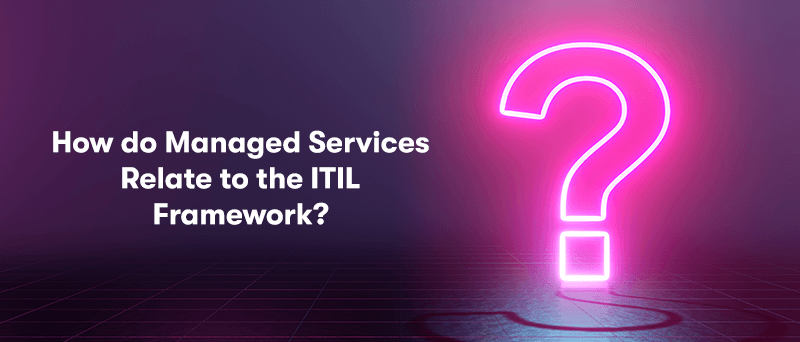ITIL® Managed Services - Everything You Need to Know
In the rapidly evolving landscape of information technology, organisations constantly seek methodologies to streamline operations, enhance efficiency, and align IT services with their strategic objectives. Enter ITIL 4 Managed Services, a paradigm shift in IT service management (ITSM) that promises to revolutionise how businesses manage and deliver IT services.
This comprehensive guide aims to demystify ITIL® 4 Managed Services, offering a deep dive into its core principles, practices, and the tangible benefits it brings. From fostering a culture of continual improvement to ensuring a seamless alignment with business goals, ITIL4 Managed Services is set to be a cornerstone for organisations aiming to thrive in the digital age.
Join us as we explore everything you need to know about ITIL 4 Managed Services, your blueprint for ITSM excellence.
What are ITIL Managed Services?
ITIL 4 Managed Services refer to the application of ITIL 4 framework principles and practices to the delivery of managed IT services. ITIL is a set of detailed practices for IT service management that focuses on aligning IT services with the needs of business. ITIL 4 is the latest version of this widely recognised framework, introduced in 2019, and it brings a more holistic and flexible approach to ITSM.
The core concept of ITIL 4 Managed Services is to provide a comprehensive, end-to-end model for designing, delivering, and continually improving tech-enabled products and services. This model emphasises the co-creation of value through collaboration between service providers and stakeholders, and it integrates concepts from other methodologies like Agile, DevOps, and Lean. Key components of ITIL 4 Managed Services include:
Service Value System (SVS)
ITIL 4 introduces the Service Value System, which provides an overarching view of how an organisation's components and activities work together to facilitate value creation through IT services. The SVS includes the ITIL service value chain, governance, guiding principles, practices, and continual improvement.
Service Value Chain
At the heart of the SVS, the service value chain is a flexible model for the creation, delivery, and ongoing improvement of services. It includes six key activities: plan, improve, engage, design & transition, obtain/build, and deliver & support, which can be adapted and connected in various ways to create multiple value streams.
Guiding Principles
ITIL 4 introduces a set of guiding principles that can be used to drive organisational decision-making and actions. These principles include focusing on value, starting where you are, progressing iteratively with feedback, collaborating and promoting visibility, thinking and working holistically, keeping it simple and practical, and optimising and automating.
Practices
ITIL 4 defines a set of 34 practices (compared to the 26 processes and 4 functions in ITIL V3), categorised into general management, service management, and technical management practices. These practices provide a more flexible approach to managing and delivering services, allowing organisations to adapt to a changing service management landscape.
Continual Improvement
A core concept of ITIL 4 is the continual improvement model, which provides a structured approach to evaluating and improving products, services, and practices over time.
Applying ITIL 4 to managed services involves leveraging these components to ensure that IT services are aligned with business needs, efficiently delivered, and continuously improved. This approach helps organisations to increase efficiency, improve service levels, manage risks more effectively, and foster innovation.
What are Some Examples of Managed Services?

Applying ITIL 4 principles to managed services involves aligning various IT services with the ITIL 4 framework's practices, principles, and models to ensure effective service management and value co-creation. Here are some examples of how ITIL 4 principles can be applied to managed services:
Managed IT Service Desk
An ITIL 4 managed service desk goes beyond traditional IT support by emphasising proactive problem management, user experience, and feedback loops to continually improve services. It utilises the ITIL 4 practices of incident management, problem management, and service request management, focusing on reducing incidents through better knowledge management and user education.
Managed Cloud Services
Utilising ITIL 4, managed cloud services focus on planning, designing, transitioning, operating, and continuously improving cloud solutions. Practices such as service design, service transition, and continual improvement are applied to manage cloud infrastructure, platforms, and software services. This ensures that cloud services are aligned with business needs and deliver value effectively.
Managed Security Services
In the context of ITIL 4, managed security services integrate with the framework's guidance on risk management, information security management, and incident management. Security operations are continually improved based on threat intelligence, incident feedback, and emerging technologies to ensure resilience against cyber threats.
Managed Network Services
Applying ITIL 4, managed network services involve activities like network design and configuration, performance monitoring, and capacity management, guided by ITIL practices such as service level management and capacity and performance management. This ensures that the network infrastructure supports business objectives and scales according to demand.
Managed Application Services
Leveraging ITIL 4 managed application services focuses on the end-to-end lifecycle of applications, from development and deployment to operation and continual improvement. Practices like software development and management, release management, and deployment management ensure that applications meet current and future business requirements.
Managed End-User Computing Services
This service applies ITIL 4 principles to manage and support end-user devices and applications, ensuring they are updated, secure, and aligned with user needs. It involves practices such as asset management, change control, and monitoring and event management.
Managed Compliance and Governance Services
By incorporating ITIL 4's focus on governance and compliance, these services help organisations align their IT operations with legal, regulatory, and industry standards. Risk management and information security management are central to ensuring that IT services comply with necessary regulations and policies.
Managed Continuity Services
Applying the ITIL 4 practice of service continuity management, these services ensure that organisations can continue to operate their critical functions during a disruption. This includes planning, implementing, and testing continuity plans to minimise downtime and impact on business operations.
These examples demonstrate how ITIL 4's comprehensive approach to service management can be applied across a wide range of IT services, ensuring they are managed efficiently, aligned with business goals, and continually improved to deliver maximum value.
How do Managed Services Relate to the ITIL Framework?

Managed services and the ITIL framework are closely related in the context of delivering and managing IT services. While managed services refer to outsourcing IT functions and processes to third-party service providers, the ITIL (Information Technology Infrastructure Library) framework provides a comprehensive set of best practices and guidelines for IT service management (ITSM). The relationship between managed services and the ITIL framework can be seen in several key areas:
Service Delivery and Management
ITIL offers a structured approach to managing IT services throughout their lifecycle, from service strategy and design to transition, operation, and continual improvement. Managed service providers (MSPs) can adopt ITIL practices to ensure that their services meet the needs of their clients, delivering value and ensuring quality and efficiency.
Alignment with Business Objectives
One of the core principles of ITIL is aligning IT services with the business objectives of the organisation. MSPs using the ITIL framework can more effectively ensure that the services they provide support their client's strategic goals, enhancing customer satisfaction and contributing to business success.
Standardisation and Best Practices
ITIL provides a standardised set of best practices for ITSM, which can be applied across different organisations and industries. This standardisation helps MSPs deliver consistent, high-quality services to their clients while enabling easier integration and management of IT services.
Continual Service Improvement
Continual improvement is a fundamental concept in ITIL, focused on constantly evaluating and enhancing services to increase efficiency, effectiveness, and adaptability. MSPs adopting ITIL practices can leverage continual improvement processes to refine their services, respond to changing customer needs, and stay competitive in the market.
Risk Management and Compliance
ITIL includes practices for managing risks and ensuring compliance with legal and regulatory requirements. MSPs can use these practices to help their clients mitigate IT risks, protect data and information, and meet compliance obligations, enhancing trust and reliability.
Incident and Problem Management
ITIL provides structured processes for managing incidents and problems, aiming to minimise the impact of incidents and prevent recurrences. MSPs can implement these processes to ensure rapid response to issues and maintain high service availability and reliability for their clients.
Cost Efficiency and Resource Optimisation
By following ITIL practices, MSPs can optimise the use of resources and manage costs more effectively, offering competitive pricing to their clients while maintaining service quality. This includes efficient service design, capacity planning, and demand management.
In summary, managed services and the ITIL framework are interconnected through the shared goal of delivering high-quality, efficient, and aligned IT services. MSPs adopting ITIL practices can enhance their service offerings, improve customer satisfaction, and achieve operational excellence, thereby fostering stronger client relationships and business growth.
What is Important to Know About ITIL Managed Services?

When considering ITIL managed services, it's important to understand how the ITIL framework influences the management, delivery, and improvement of IT services. Here are key aspects to consider:
Alignment with Business Goals
ITIL emphasises aligning IT services with the organisation's business objectives. Managed service providers (MSPs) using ITIL practices focus on understanding their client's business needs and ensuring that IT services support these goals, facilitating growth and success.
Standardisation and Best Practices
ITIL provides a comprehensive set of best practices for IT service management, helping to standardise processes across the IT industry. This standardisation ensures that MSPs deliver consistent, high-quality services, which is crucial for maintaining reliability and building trust with clients.
Continual Improvement
A core principle of ITIL is the continual improvement of services and processes. MSPs adopting ITIL are committed to regularly evaluating and enhancing their service offerings to meet evolving client needs and to adapt to changing technological landscapes.
Efficiency and Effectiveness
ITIL practices help MSPs to operate more efficiently by streamlining processes, reducing redundancies, and optimising resource utilisation. This leads to cost savings, improved service quality, and better client satisfaction.
Risk Management
ITIL includes guidelines for identifying, assessing, and managing risks associated with IT services. MSPs leveraging ITIL can help clients minimise potential disruptions, ensure data security, and comply with regulatory requirements.
Incident and Problem Management
Effective incident and problem management processes are vital for maintaining service continuity and reliability. ITIL provides structured approaches for dealing with incidents and problems, ensuring quick resolution and minimising impact on business operations.
Clear Roles and Responsibilities
ITIL defines clear roles and responsibilities for service management, which helps establish clear accountability and efficient process execution. This clarity is essential for MSPs to deliver services effectively and to coordinate seamlessly with client organisations.
Customer Focus
ITIL places a strong emphasis on customer satisfaction and the co-creation of value. MSPs using ITIL practices focus on understanding and meeting customer needs, ensuring services are tailored to deliver maximum value.
Measurement and Reporting
ITIL advocates for the measurement and reporting of service performance against agreed-upon metrics and service level agreements (SLAs). This transparency is crucial for continuous improvement and maintaining strong, trust-based relationships between MSPs and their clients.
Understanding these aspects of ITIL-managed services can help organisations make informed decisions when selecting an MSP and can guide MSPs in delivering services aligned with ITIL's best practices and principles.
Final Notes on ITIL Managed Services
In conclusion, our exploration of ITIL 4 Managed Services and their application has unveiled the transformative potential of aligning IT services with business objectives through the ITIL framework. Organisations can navigate the complexities of modern IT environments by understanding the essence of managed services, examples of ITIL 4 applications, and their synergy with ITIL principles.
This knowledge equips businesses and managed service providers alike to embrace standardisation, continual improvement, and strategic alignment, ensuring efficient, effective, and resilient IT service delivery.
As we've uncovered, integrating ITIL best practices into managed services is beneficial and essential for fostering growth, innovation, and competitive advantage in today's digital landscape.



